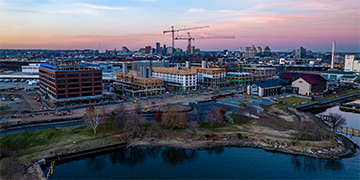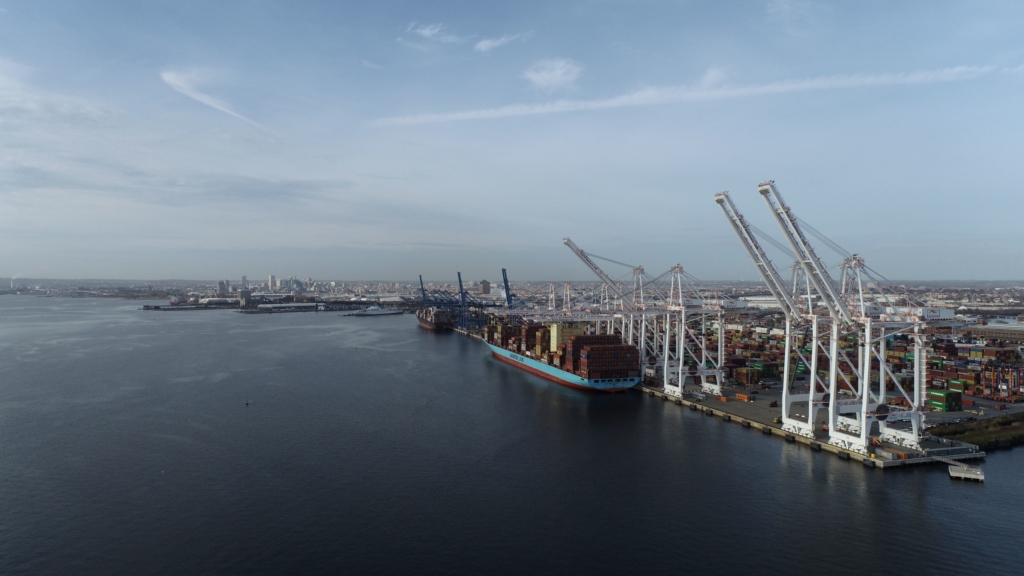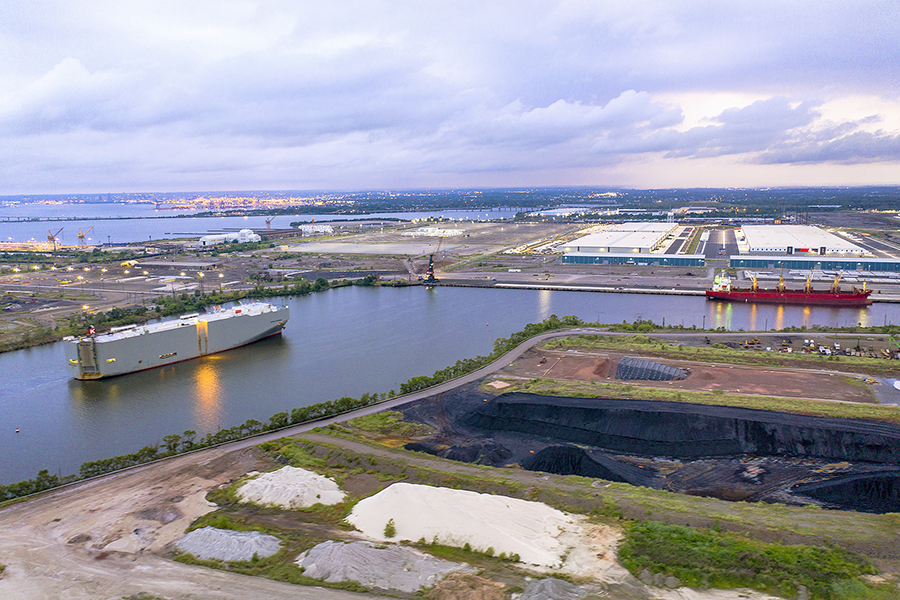Could new infrastructure transform Maryland’s economy?
Economic development experts compare it to the construction of the interstate highway system.

Federal infrastructure funds, analysts say, have the potential to trigger “generational change” in Maryland’s economy. That could include growing the innovation economy and making developments, such as Port Covington, prime locations for leading technology and life sciences companies. Photo courtesy of Port Covington Development Team
The federal Infrastructure Investments and Jobs Act (IIJA) will deliver $973 billion to Maryland over the coming five years to improve roads, bridges, transit, rail lines, broadband, cybersecurity, EV charging networks and more. The direct economic impact of that investment will be enormous. Based on his most recent analysis for NAIOP, George Mason University Professor Emeritus Dr. Stephen Fuller estimates that the IIJA will generate nearly $632.5 billion in personal income for Maryland residents and contribute nearly $1.89 trillion to the state GDP over the next five years.
But those are just the near-term impacts. Like the interstate highway system, the infrastructure package has the potential to trigger transformational change in local economies and industries.
“Using this money to fix deficiencies in our existing infrastructure is very important to our economy,” Fuller said. “But it can also be used to create new capabilities, new efficiencies, perhaps substitute new modes and technologies for old infrastructure. What will best serve Maryland in 2040? Those kinds of investments could have long-term positive economic consequences for the state and make Maryland more competitive within the national economy. If I was the governor, I would ask, what is holding back our economy the most and how could I spend this money to fix it.”
Economists, analysts and planners (including some individuals who are already involved in talks about infrastructure projects) say strategic and bold use of IIJA funds could spur major expansion in Maryland’s transportation, distribution and logistics industries; support important growth in the innovation economy; spark a new era of manufacturing in Maryland; and ease some entrenched challenges involving available workforce, affordable housing and urban life.
“We could be talking about projects that have the potential to have generational impact,” said Tom Sadowski, Executive Director of the Maryland Economic Development Corporation (MEDCO). “This could be transformational for Maryland.”
Moving goods, making goods
Maryland’s booming distribution and logistics sector proved its capabilities during the pandemic and global supply chain challenges.

It could also drive further growth at the Port of Baltimore, expand the state’s transportation and logistics industries, and spark a new era of manufacturing in Maryland. Photos courtesy of the Maryland Port Administration.
“We have heard Governor Hogan speak recently about how shipping capacity is shifting away from the West Coast to the East Coast because of the capabilities we have,” Sadowski said.
Now, the sector is poised for even more growth. The arrival of post-Panamax cranes at the Port of Baltimore and the start of construction on the Howard Street tunnel project will drive more cargo through Maryland. IIJA-funded improvements to highways, bridges, rail lines and port infrastructure (such as expanded berthing capacity, deeper shipping channels and new equipment to move cargo) “will support further growth of the Port of Baltimore and lead to many more opportunities in the transportation, distribution and logistics sector,” said Aaron Tomarchio, Executive Vice President Corporate Affairs at Tradepoint Atlantic.
Industry watchers expect the growth in industrial properties in Maryland will stretch beyond distribution centers and include new manufacturing facilities.
“I see significant opportunities down the road in manufacturing and value-added work,” Sadowski said. “You are not just dealing with logistics but the onshoring of manufacturing capabilities that currently reside abroad. The supply chain strains we have seen recently combined with Maryland’s logistical advantages create opportunities for the dawning of a new industrial age here with more products being produced in Maryland, more value-added work completed here and the state becoming a supply chain solutions provider.”
Tradepoint Atlantic already appears to be pursuing some of those manufacturing opportunities.
“There is a concerted effort to onshore parts of the nation’s supply chain and the manufacturing elements that support that supply chain,” Tomarchio said. “We have had a number of active conversations with companies looking to onshore manufacturing operations.”
Innovation infrastructure
The IIJA – which includes funds for broadband, cybersecurity, renewable energy and transit – could also stoke Maryland’s innovation economy.
“We need to think more broadly about how infrastructure investments support the economy,” Sadowski said. “We have to think about our innovation infrastructure as well. Where can we make investments so that the significant research and development work that is done here in Maryland is translated into new, innovative products and services. There have been discussions about the availability of lab space and secure space for cyber and quantum computing research and development. At MEDCO, we are putting ourselves out there as an active partner for any of those types of projects.”
Investments in innovation infrastructure which could also happen through public-private partnerships, along with investments in transportation, broadband and energy could make Maryland more attractive to high-tech companies and professionals.
“In the long term, it should further solidify Maryland as the premier location for technology, innovation and bio/life sciences by providing new, state-of-the-art infrastructure from which additional private investment can be realized,” said Adam Genn, Managing Director of Development at Weller Development Company.
Strengthening communities, building workforce
Some economic development and commercial real estate experts say components of the IIJA could also be pivotal to easing longstanding challenges in Baltimore City and other communities, and to expanding Maryland’s workforce.
“Just look at the 2020 Census data,” said said Dr. Seema Iyer, Associate Director of the Jacob France Institute at the University of Baltimore. “Baltimore was the only city on the Eastern Seaboard that lost population. Every other city from Richmond to Boston gained population, including Newark, New Jersey and Providence, Rhode Island. Philadelphia posted its biggest gain. If you think about why those cities grew and Baltimore did not, it is because they invested in infrastructure in the 70s and 80s in ways that Baltimore did not. Philadelphia finished its Septa line in 1985 and in the past decade it posted record growth.”

The arrival of post-Panamax cranes, the launch of the Howard Street Tunnel project and new federal infrastructure dollars are positioning Baltimore to be a transportation, logistics and “supply chain solutions” hub. Analysts predict that trend will also include the creation of new manufacturing facilities in Maryland. Photo courtesy of Tradepoint Atlantic.
Further analysis of the Census data shows that “parts of the city and the region that continue to lose population tend to be the areas that have the worst infrastructure whether it is water and sewer, flooding, lack of transit or lack of broadband,” Iyer said.
The federal infrastructure package can – and needs to – produce rapid improvements in those areas that are experiencing serious deficiencies, Iyer said. For example, the plan to spend $22 million in federal infrastructure money to improve bus service along the east-west corridor from Essex to Woodlawn would provide residents with better access to jobs.
“Today, it can take three bus changes and 90 minutes to get from parts of West Baltimore to East Baltimore,” said Dr. Darius Irani, Chief Economist of the Regional Economic Studies Institute at Towson University. “There are many people in this region who are willing and able to work but don’t have cars. For them, an inefficient and incomplete transit system creates a real barrier to employment.”
In addition to benefiting individuals and helping employers access needed workforce, those kinds of investments could drive growth in communities that are struggling economically.
While preparing for Weller’s Port Covington development, the SB7 coalition of South Baltimore communities created a strategic plan to revitalize the area “through investments like mobility, equity, air quality, community waste and mixed-income/affordable housing,” Genn said. “We are in a unique moment in time and place where federal dollars are available to deploy funds into initiatives and neighborhoods which have been neglected for years. The outcomes from these investments provide the opportunity to change the trajectory of people’s lives… Investment in roads, water, sanitary, broadband, energy, housing and transit will put Baltimore on a trajectory for growth.”